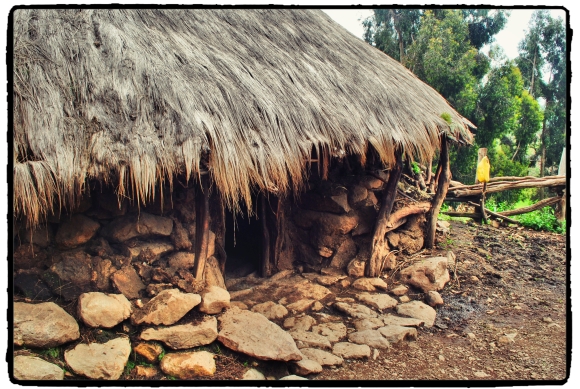Four Days of Walking
For the four days Liz and I trekked through the Simien Mountains, the smell of wild thyme followed us. The wind was full of strong gusts of the scent that reminded me of old, unidentifiable memories, as we hiked from one beautiful vista to the next, among wild baboons, birds, and ibex. It seemed like we were forever pausing at a cliff side to stare out on blue-green rolling mountains from the roof of Africa. At one point, I noticed that the horizon was never straight, always slanted, which could explain why it also always felt as though we were trudging uphill. It felt that way because it was that way.
Because of the season, and the rains that came every day, the park was filled with a dozen shades of green, from the dark army green of lichen hanging from low, umbrella-like trees, to the bright yellow-green of terraced barley fields, and the pale yellow-green of tufts of wild grass in between. Bursts of yellow, purple, and a muted pink from wildflowers filled the gap and I could never seem to take a photo good enough to record just how beautiful this mixture of color looked.
With the colors, the rain also brought mud and clouds. We trekked through muck, hopped across streams, and sometimes found the trail had turned in to a river. On our final day of the trek, we hiked 400 meters to the top of a peak through cold rain and hail, only so we could eat cabbage sandwiches in a cloud and stare at more cloud. From the top of a second peak, we waited for half an hour, chatting, eating cookies, with a pair of chain-smoking French tourists, watching the clouds move over the valley, waiting for them to part just well enough for us to see and understand just how high up we were.
On our first full day, we took refuge from the rain in a rounded hut, while an elderly woman with a worn, yellow scarf, slowly roasted coffee for a coffee ceremony. Our guide, who we all thought to be shifty and easily offended, sat in the corner and sipped his coffee, while our scout, who we all gathered to be well liked and jovial (even though he only spoke about 10 words of English), sat at the center making jokes in Amharic and making the old woman and her daughter laugh. The rest of us, excluded because of our linguistic shortcomings, fell into conversation amongst ourselves.
Coming down from the mountains to our campsite on the second day, a group of rag-tag children came sprinting up the mountain with little woven boxes in hand that they wanted to sell us. It wasn’t the first time this had happened, but we were tired, so we paused to play and joke with them. They tried to teach us how to use a whip to herd donkeys, and we tested their English. One of the girls began mocking the Canadian girl’s laugh, which sent all of us, especially our elderly scout, into riotous laughter.
That night, like every night, we descended into our campsite feeling wet, cold, and tired, but eager to eat whatever it was our cook had whipped up. Usually, she made an Ethiopian interpretation of what Western food was, but we didn’t know how to say that we’d rather just have injera and shiro.
On our final day, Liz and the other American raced up a nearby peak, while the Canadian girl and I wrote in our journals on a cliff by our campsite, watching a bird that always sounded like he was burping dive in and out of the sky. Like that we stayed until nearly dusk, waiting for our car to pick us up. When we asked our guide “what will we do if our driver doesn’t show up?” — being North Americans who need a contingency plan — he shrugged and gave us a vague “we’ll do something” response. Serendipitously, our car showed up just as I was trying to process what “something” would mean, and we drove back to Gondar at 5 mph in a thick mask of fog.
How to travel to the Simien Mountains
Anyone who travels to the Simiens needs to hire a scout at minimum. Some people recommend having a guide, since scouts don’t usually speak English, but I would have been fine without ours! They’re cheap, only a few dollars a day, though it’s polite to tip at the end as well.
Cooks are optional, but affordable and nice to have someone else make your food after a long day of hiking. Also, if you hire donkeys to carry your bags, a cook will make sure they get to the next campsite. Hiring a donkey to carry your bag is also optional, but nice.
All of this can be arranged in Gondar or at the park office in Debark. Starting and ending in Debark is a good way to save a little money, and convenient if you are heading north to Axum after the trek (going back to Gondar is about an hour or two of backtracking).
In the end, we spent about $220 each for everything (food, transportation to/from Gondar, guide, cook, scout, permits, donkeys, and lodging) for 4 days and 3 nights of trekking.
Photos
 {1} Vista on the roof of Africa
{1} Vista on the roof of Africa
{2} Flowers along the trail
{3} Waiting for the clouds to part from a summit
{4} Traditional house in the Simiens
{5} Getting ready to go at Campsite #2
{6} Baboons by a waterfall
{7} The road in/out
{8} Scouts and guides talking around a campfire while a local girl visits






